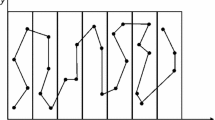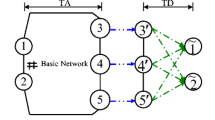Abstract
Many trip distribution models used in transport systems planning are designed to solve maximum entropy optimization problems. Discrete by nature, they must be transformed into continuous and differentiable problems, typically by applying the first-order Stirling approximation. Although it does a reasonable job for large trip flows, this approximation produces significant errors when flows are small. This paper presents two alternatives using the second-order Stirling approximation and Burnside’s formula to specify new distribution models that improve prediction for small trip values. In an application to real data for the Santiago, Chile metro system, both proposed formulations obtained results with superior goodness-of-fit and predictive capacity to a traditional model using a first-order Stirling approximation. The version incorporating the second-order Stirling approximation delivered the best performance.







Similar content being viewed by others
References
Abrahamsson T, Lundqvist L (1999) Formulation and estimation of combined network equilibrium models with applications to Stockholm. Transp Sci 33:80–100
Alonso W (1973) National Interregional Demographic Accounts: A Prototype. Monograph 17, Institute of Urban and Regional Development. University of California, Berkeley
Alonso W (1986). Systemic and Log-Linear Models: From Here to There, Then to Now, and This to That. Discussion paper 86–10, Centre for population studies, Harvard University.
Anas A (1981) The estimation of multinomial logit models of joint location and mode choice from aggregated data. J Reg Sci 21(2):223–242
Anas A (1983) Discrete choice theory, information theory and the multinomial logit and gravity models. Transp Res 17:13–23
Bar-Gera H, Boyce D (2005) Userequilibrium route set analysis of a large road network. In: Mahmassani H (ed) Transportation and Traffic Theory: Flow, Dynamics and Human Interaction. Elsevier, Oxford, pp 673–692
Bikker JA (1992) Internal and external trade liberalization in the EEC: an econometric analysis of international trade flows. Econ Appl 45:91–119
Boyce DE (2007) Forecasting travel on congested urban transportation networks: review and 4 prospects for network equilibrium models. Netw and Spat Econ 7:99–128
Boyce D, Bar-Gera H (2003) Validation of multiclass urban travel forecasting models combining origin–destination, mode, and route choices. J Reg Sci 43:517–540
Boyce DE, Bar-Gera H (2004) Multiclass combined models for urban travel forecasting. Netw and Spat Econ 4:115–124
Briceño L, Cominetti R, Cortés C, Martínez FJ (2008) An integrated behavioral model of land-use and transport system: an extended network equilibrium approach. Netw and Spat Econ 8:201–224
Burnside W (1917) A rapidly convergent series for log N! Messenger Math 46:157–159
De Cea J, Fernández JE, De Grange L (2008) Combined models with hierarchical demand choices: a multi-objective entropy optimization approach. Transp Rev 28:415–438
De Grange L, Fernández JE, De Cea J (2010a) A consolidated model of trip distribution. Transp Res 46E:61–75
De Grange L, Fernández JE, De Cea J, Irrazábal M (2010b) Combined model calibration and spatial aggregation. Netw and Spat Econ 10:551–578
De Grange L, Ibeas A, González F (2011) A hierarchical gravity model with spatial correlation: mathematical formulation and parameter estimation. Netw and Spat Econ 11:439–463
De Grange L, Boyce D, González F, Ortúzar JD (2013) Integration of spatial correlation into a combined travel model with hierarchical levels. Spat Econ Anal 8:71–91
De Vos AF, Bikker JA (1982) Interdependent multiplicative models for allocation and aggregates; a generalization of gravity models. Onderzoeksverslag IAWE-80. Vrije Universiteit, Amsterdam
Donoso P, De Grange L (2010) A microeconomic interpretation of the maximum entropy estimator of multinomial logit models and its equivalence to the maximum likelihood estimator. Entropy 12:2077–2084
Donoso P, De Grange L, González F (2011) A maximum entropy estimator for the aggregate hierarchical logit model. Entropy 13:1425–1445
Fang SC, Tsao SJ (1995) Linearly-constrained entropy maximization problem with quadratic cost and its applications to transportation planning problems. Transp Sci 29:353–365
Fang S, Rajasekera J, Tsao H (1997) Entropy Optimization and Mathematical Programming. Kluwer Academic Publishers, Norwell, MA
Feller W (1966). An introduction to probability theory and its applications - Vol 1, 2nd Edn. Wiley Publications, 50–51.
Florian M, Wu JH, He S (1999) A multi-class multi-mode variable demand network equilibrium model with hierarchical logit structures. IX Congreso Chileno de Ingeniería de Transporte, Santiago, 18–22 Octubre 1999
Fotheringham AS (1983) A new set of spatial interaction models: the theory of competing destinations. Environ Plan 15A:15–36
Fotheringham AS (1986) Modeling hierarchical destination choice. Environ Plan 18A:401–418
Fotheringham AS, O’Kelly ME (1989) Spatial interaction models: formulations and applications. Kluwer Academic Publishers, Dordrecht
Gonçalves M, Souza JE (2001) Parameter estimation in a trip distribution model by random perturbation of a descent method. Transp Res 35B(2):137–161
Guldmann JM (1999) Competing destinations and intervening opportunities interaction models of inter-city telecommunication flows? Pap Reg Sci 78:179–194
Ham H, Tschangho JK, Boyce D (2005) Implementation and estimation of a combined model of interregional, multimodal commodity shipments and transportation network flows. Transp Res 39B:65–79
Hasan MK, Dashti HM (2007) A multiclass simultaneous transportation equilibrium model. Netw and Spat Econ 7:197–211
Hazewinkel M (2001). Stirling formula. Encyclopaedia of mathematics, Springer, ISBN 978–1556080104.
Kitthamkesorn S, Chen A, Ryu S, Xu X (2013) Modeling mode and route similarities in network equilibrium problem with Go-green modes. Netw and Spat Econ, Online First. doi:10.1007/s11067-013-9201-y
Knudsen CD, Fotheringham AS (1986) Matrix comparison, goodness-of-fit and spatial interaction modeling. Int Reg Sci Rev 10:127–147
Morrison WI, Thumann RG (1980) Lagrangian Multiplier Approach to the Solution of a Special Constrained Matrix Problem. J Reg Sci 20(3):279–292
Orpana T, Lampinen J (2003) Building spatial choice models from aggregate data. J Reg Sci 43:319–347
Sen A, Matuszewsky Z (1991) Maximum likelihood estimates of gravity model parameters. J Reg Sci 31:469–486
Thorsen I, Gitlesen JP (1998) Empirical evaluation of alternative model specifications to predict commuting flows. J Reg Sci 38:273–292
Wilson AG (1970) Entropy in Urban and Regional Modeling. Pion, London
Acknowledgments
The authors are grateful for funding provided by the Fondecyt 1140163.
Author information
Authors and Affiliations
Corresponding author
Rights and permissions
About this article
Cite this article
de Grange, L., González, F., Muñoz, J.C. et al. An Improved Stirling Approximation for Trip Distribution Models. Netw Spat Econ 14, 531–548 (2014). https://doi.org/10.1007/s11067-014-9253-7
Published:
Issue Date:
DOI: https://doi.org/10.1007/s11067-014-9253-7




